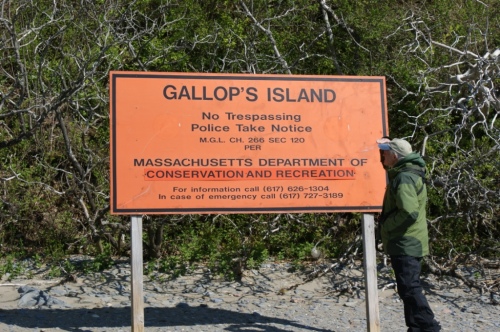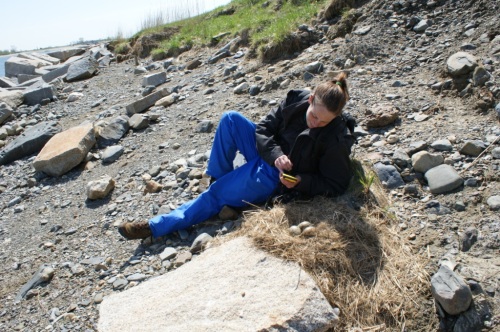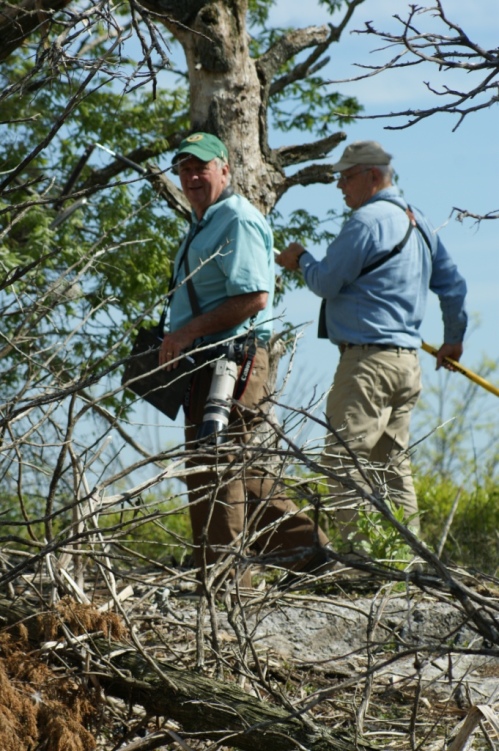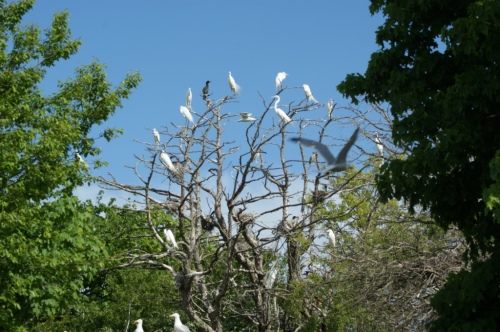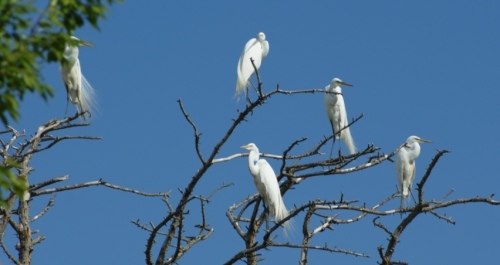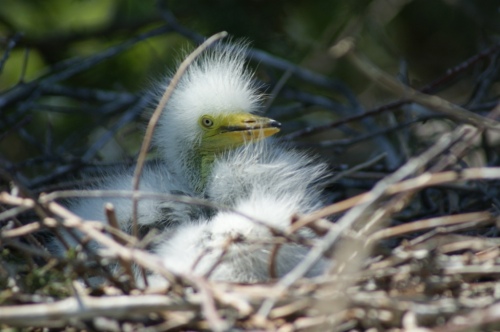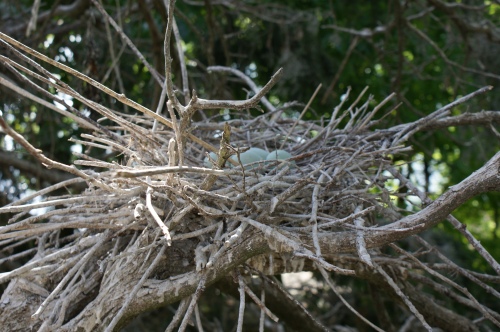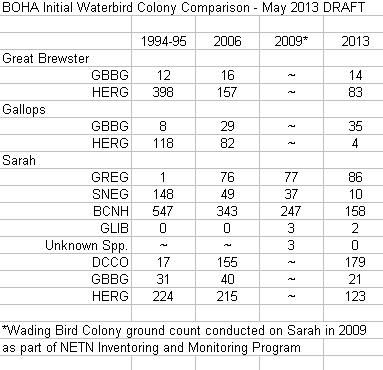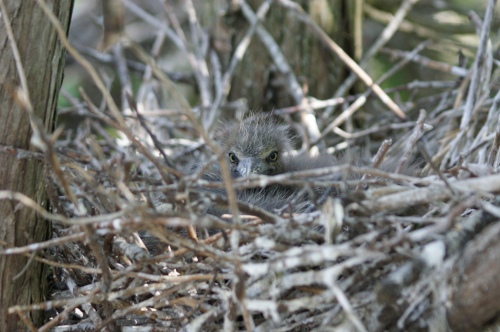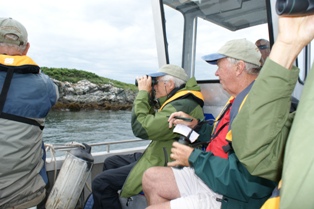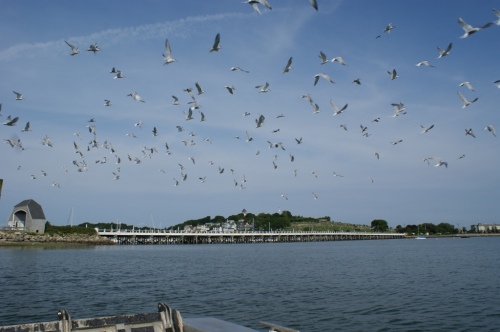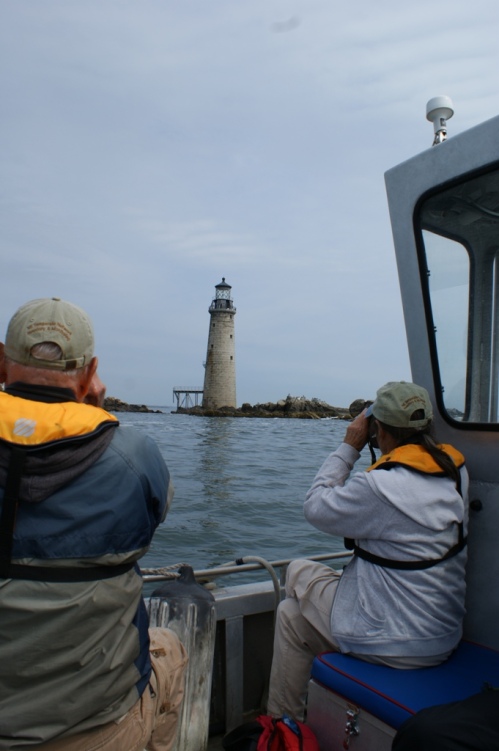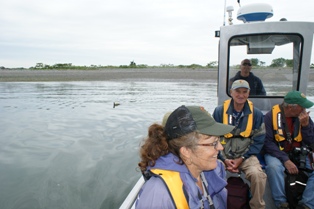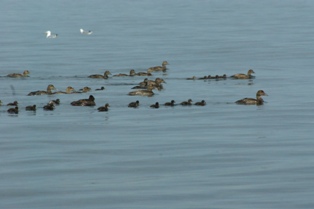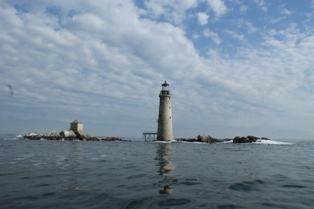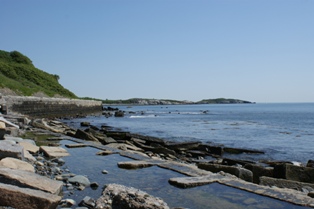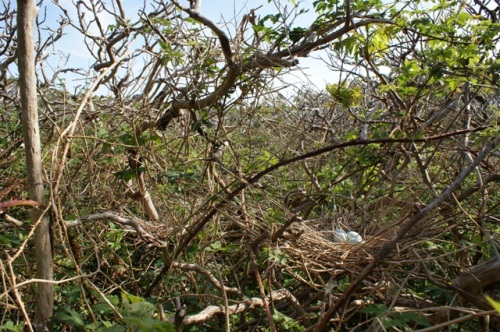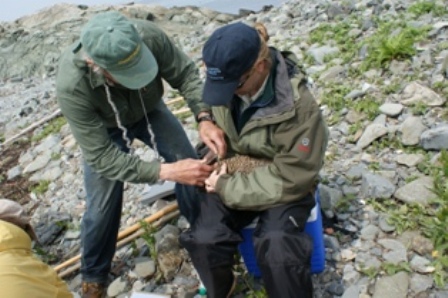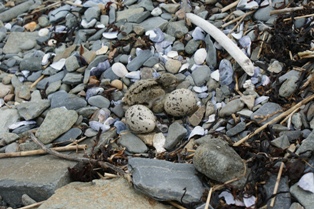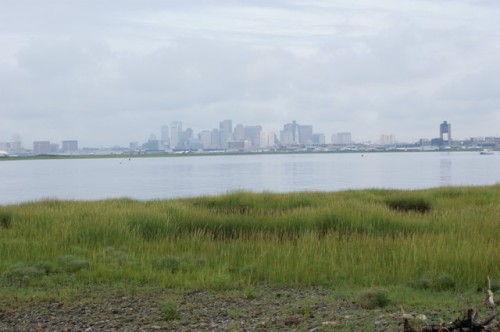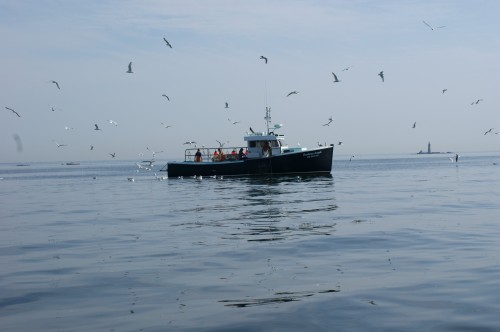Check out the recently added “News & Events” page to see a list of upcoming events in the parks and to catch some headlines.
We got the 2013 season off to a great start this week with eager and able volunteer crews and very cooperative weather!
On Monday, May 13th, we conducted ground-based counts on Great Brewster and Gallops Islands. (Thanks to DCR and Rob Lowell for permission and instructions for visiting Gallops which is currently closed to the public).
On Great Brewster, we had a total of 83 Herring Gull (HERG) nests and 14 Great Black-backed Gull (GBBG) nests, as well as one American Oystercatcher (AMOY) presumed to be nesting on the landing beach and another territorial pair on the south end of the island. We also flushed several Common Eider (COEI), though we did not comprehensively search for eider nests. On Gallops Island, we had 35 GBBG nests, 4 HERG nests, 2 COEI nests and 2 AMOY nests with locations known. New volunteers Carol and Alexis jumped right in… and got comfortable very quickly!
On Thursday, May 16th, we conducted a thorough ground-based count of Sarah Island. We detected a total of 123 HERG nests and 21 GBBG nests throughout the island, along with 179 tree-nesting Double-crested Cormorants (DCCO).
Wading bird numbers were down significantly from the last count in 2009, though Great Egrets seem to be holding their ground.
In total on Sarah we found 158 Black-crowned Night Herons (BCNH) nests, 86 Great Egret (GREG) nests, 10 Snowy Egret (SNEG) nests, and 2 Glossy Ibis (GLIB) nests. We also found 5 pairs of nesting Canada Geese, 2 America Black Duck nests, and a Common Grackle nest in amongst the waders. In addition, there was a pair of territorial AMOY on the south side of Sarah, though no nest was detected.
Our timing was great this year – most of the waders were on eggs with just a few nests of young GREGs and BCNHs. This timing is ideal to maximize information about the full season’s nesting effort, but minimize the disturbance we create at the colony site. We did notice a large number of Black-crowned Night Herons in the trees on Langlee Island that did not appear to be birds flushed from Sarah, but a quick landing on Langlee did not turn up any signs of nesting there.
Below is a draft comparison of numbers from these 3 sites from the State census counts in 1994-5 and 2005-6, as well as our wader numbers from Sarah in 2009. Unfortunately, it doesn’t paint a very pretty picture at first glance… This year, colonial nesting bird surveys are being conducted not only throughout the rest of Massachusetts, but also region-wide from Virginia to Maine. It will be very interesting to see the results come in and find out if the trends we are seeing in Boston Harbor match what is happening in the rest of the region.
Next week we are planning to get to the wading bird colony on Sheep Island and hopefully learn what others are finding out about ‘our’ birds on Outer and Middle Brewster and Calf Islands, which are also being surveyed this year. More soon – Happy Spring!
Posted in Boston Harbor Islands, Coastal breeding birds, Monitoring | Leave a Comment »
Hi all!
We wrapped up the season last Thursday with boat-based surveys of Snake Island and the Outer Harbor. We observed 7 adult American Oystercatchers with 4 chicks on Snake, as well as one adult on Fisherman’s Bend in Winthrop and one adult on the shore of the Logan runway. Susannah reported 5 fledged chicks on Snake earlier in June. Of the four we saw last Thursday, 3 were two young to have been observed in June, indicating that Snake has potentially produced at least 8 fledged chicks this season!
Unfortunately, observations of oystercatcher productivity elsewhere in the Harbor have been less fruitful… We observed 2 adults on Calf, 1 adult on Little Calf, 1 adult on The Graves, and 1 adult on Shag Rocks, all feeding intertidally. No other fledged chicks were observed. A summary of oystercatcher observations throughout the 2012 season and our ‘best guesses’ for productivity outcomes are attached.
Other items of note on Thursday were a Whimbrel on Green Island, and 6 harbor seals hauled out on The Graves. We also noted feeding Spotted Sandpipers on Snake, Calf, Little Calf, Green, Middle Brewster, and Outer Brewster.
Thanks you all for a wonderful season!
Posted in Uncategorized | Leave a Comment »
Hi everyone!
Things are definitely winding down for the season in Boston Harbor (at least bird-wise). On Thursday we spent the morning following up on American Oystercatcher pairs observed earlier in the season. We detected active pairs on Button and Sarah in Hingham Harbor, as well as a pair on Grape Island. Oddly, one of the adults on Button appeared to be incubating, which seems unlikely given the late date… We also detected 9 adult oystercatchers on Sheep Island and another 3 on Hangman.
During a landing on Great Brewster we found only a single pair of oystercatchers on the south end of the island. There were two pairs nesting on the landing beach earlier in the season. In a trip around the Outer Islands we observed 3 adult oystercatchers in flight on the south end of Calf and another adult on the rocks off the east side of Calf. We also detected an adult (may have been the same previously seen in flight) on the west end of Middle Brewster. There were no pairs observed on Green or Outer Brewster where we had observed them earlier in the season. No oystercatcher chicks were observed.
Other items of note: Wading birds colonies were still quite active on Sarah and Sheep. We spotted a Harbor Seal off Hangman. And we observed many Spotted Sandpipers feeding on the rocks all over the place! We also noted a handful of young eider in the Outer Islands, but remaining chicks are now large enough to be extremely difficult to distinguish from adult females, so no formal survey was conducted.
Hope you are all having a great summer! Our last trip will be on July 26th, after which I’ll provide a more complete summary of American Oystercatcher observations for the season.
-Carol
Posted in Uncategorized | Leave a Comment »
Yesterday’s effort ended in heavy rain at 8:20am, but we got in a solid hour+ of work before that came to pass…
It appears that the tern colony on Lovell’s has been abandoned for this season. Rangers have reported a rat infestation and we saw ample rat tracks during our visit yesterday. After being washed out by the early June moon tide it appears they’ve given for this year. Good news is that, although two adults were hanging around, it looks like the Great Black-backed Gull pair that was nesting in the tern colony on Lovells also gave up for the season after being overwashed earlier in the month. Adult and young Killdeer were still running all over the beach!
We began a boat-based survey for eider ducklings in the Outer Harbor and made it to The Graves before the rain came. At that point we’d counted 113 females without ducklings and 11 females accompanying a total of 6 ducklings in 3 separate crèches. For comparison, looking at a comparable portion of the survey from June 12th, we had 91 females without ducklings and 16 females with 10 ducklings. Although I’d like to think there were a whole bunch of eider ducklings hiding out somewhere we didn’t get too, I tend to suspect this was a low productivity year for Common Eider in the Harbor Islands. While in the Outer Islands Friday we also observed adult American Oystercatchers on Calf and Green Islands (we did not get to the Brewsters).
Hope everyone is enjoying a good start to summer and has a Happy Fourth of July!
-Carol
Posted in Uncategorized | Leave a Comment »
Good morning everyone. Sorry for the delay in getting this out… we had a productive, though somewhat disappointing, trip to the islands last Tuesday, June 12th. Our goal was to conduct our official visit island tern nesting areas within the State survey window and to check up on active AMOY pairs and eider ducklings.
We started the day with a visit to Snake Island where we confirmed 5 pair of territorial American Oystercatchers and 3 pair of Willets. There were no terns nesting on Snake this year. We then proceeded to the tern nesting platform off of Spinnaker Island in Hull. Unfortunately, it isn’t possible to access the platform directly, but upon flushing birds, we estimated adult 163 Common Terns attending the colony. This number is about in the middle when compared to recent years (2011: 133 adults; 2010: ~260 adults; 2009: 130 adults; 2008: 250 adults).
A boat-based survey in the Outer Islands turned up a total of only 16 eider ducklings attended by 25 females. We detected another 274 females with ducklings in the area. For comparison, on May 31st we detected 214 eider ducklings accompanied by 153 females, so these numbers have shifted dramatically. In general, we have had our high counts for the season occur in mid-June. This season was definitely a little ahead of schedule, but nonetheless, anecdotally appears to have been a year of high duckling mortality which is not uncommon for this species. During eider crèche surveys we observed 3 adult American Oystercatchers feeding on Green Island and 1 additional adult on Calf.
- Looking for Common Eider ducklings in The Graves (CLT, 6.12.2012).
We ended the day with a stop at the tern nesting colony on Lovells Island. It appeared that the site did overwash during high tides the previous weekend, but there were 5 adult terns in the area and we located 4 1-egg nests, indicating a likely renesting effort. A number of empty scrapes were also present, so numbers could be growing. The Killdeer nesting on Lovells appears to have been successful and several cotton-ball Killdeer chicks were running around. The two Great Black-backed Gulls were still in the area, but it did appear that their nest was also overwashed in the June moon tide.
This week’s trivia question: Can you identify all the tracks appearing in the attached picture from the beach at Lovells? Hint: there are 4 species represented…
Hope everyone’s week is off to a good start! -Carol
Posted in Birds, Boston Harbor Islands, Coastal breeding birds, Monitoring, Uncategorized | Leave a Comment »
Busy week, last week! On May 30thwe had planned to visit Sarah Island to count nests in the wading bird colony located there, but a preliminary boat-based survey around the island indicated that we had already missed our opportunity for this season.
Many chicks were present in the colony, and some visible egret chicks were already quite large. Visiting a colony when large chicks are present can cause tremendous disturbance with serious consequences. If young are mobile enough to ‘branch’ when scared, you run the risk of young falling from the nest site. Because herons and egrets are altricial and require parental care, any earlier-then-planned exit from the nest can result in abandonment and starvation… needless to say, this is not a scenario we want our survey efforts to produce. Although we would have liked to have included Sarah with the other wading bird sites in the park this year, it will become a priority next May. Boat-based observations did count 87 nesting Double-crested Cormorants on Sarah and ascertain that Great Egrets, Snowy Egrets, Black-crowned Night-Herons, and Glossy Ibis were all present and nesting there.
With a high tide in Hingham Harbor and no herons to survey, we decided to conduct a boat-based survey in search of American Oystercatcher pairs. One pair of AMOY were detected on Button, as well as a pair on Bumpkin and one quiet adult that may have been one half of a pair on Slate. Three pair of AMOY (1 with 2 chicks and 1 with 1 chick) were observed on Sheep Island, along with nesting GREGs, SNEGS, GLIBs, and BCNHs and 13 DCCOs. We also located a pair of AMOY and an extra adult on Hangman. No American Oystercatchers were observed on Langlee, Ragged, Sarah, Grape, or any of the south facing beaches of Peddocks (including Prince’s Head).
We finished our day last Wednesday with a ground based survey of Rainsford Island where we observed 2 pair of territorial American Oystercatchers, one with 2 chicks. We also observed 7 Spotted Sandpiper territories, but did not locate any nests. No terns were active in the area.
However, while we were searching the island, Russ was befriended by a very social female Mallard. She apparently became quite besotted with him (with no encouragement on his part) and hopped in and out of the landing craft trying to attract his attention. Upon leaving the island she attempted to follow the boat, swimming along behind and taking short flights to keep up with us… A transplant from the public garden, perhaps?
On Thursday, May 31stwe started the day with a boat-based survey in the Outer Islands where we counted 214 eider ducklings accompanied by 153 females.
Generally, our highest counts of the season occur in mid-June, so this number may still be rising though everything has generally been a little ahead of schedule this spring… We also observed 3 pairs of American Oystercatchers on Calf Island and 1adult from the pair nesting on Middle Brewster. We did not see the pair previously nesting on the landing beach on Outer Brewster.
A ground-based survey of Great Brewster resulted in 2 pair of territorial American Oystercatchers and one Common Eider nest.
We ended the day with a visit to Lovells where 8 adult Least Terns were observed actively defending the colony site.
Unfortunately, we also observed a Great Black-backed gull nest with 2 eggs in the same area. One pair of American Oystercatchers were observed loafing in the intertidal are on the west side of the island and 4 Spotted Sandpipers were noted feeding intertidally on the east side. We were also confronted by an adult Killdeer doing her absolute best to convince us that she (with 2 broken wings!) was an easy target
and that we shouldn’t waste our time continuing on the path from the beach to the center island that just happened to have her nest, with four perfect eggs, planted right in the middle of it!
Till next week! -Carol
Posted in Birds, Boston Harbor Islands, Coastal breeding birds, Monitoring | Leave a Comment »
Hi everyone,
On May 17thwe did a ground-based survey on Outer Brewster looking for Common Eider and wading birds. We conducted a thorough search of all but the very eastern tip of the island and found 42 Common Eider nests (average of 4.41 eggs). We estimated approximately 135 adult Black-crowned Night-Herons, 27 Snowy Egrets, 7 Glossy Ibis, and 1 Great Egret in residence in the center island colony. Upon closer inspection we were able to access and count 41 BCNH nests, 21 SNEG nests, and 3 GLIB nests. Snowy Egrets appear to be significantly more abundant then when last counted (12 nests) in 2009. Black-crowned Night-Heron nests were also more abundant then previous counts (36 in 2009). A pair of American Oystercatchers was also observed nesting on the landing beach and a nest with 2 eggs was located. Although (as you all know!) we focus our efforts EXCLUSIVELY on waterbirds, we also collectively (read – Bob & Wayne) managed to spot a variety of migratory species moving through the island, including Parula, Black-throated Blue Warbler, Magnolia Warbler, American Redstart, Common Yellowthroat, Black-and-White Warbler, Black-capped Chickadee (!), Veery, Savannah Sparrow, Ruby-throated Hummingbird, and an unidentified Empidonax flycatcher.
On May 18th we conducted our first boat-based survey in the Outer Islands. We confirmed what we think was a third pair of AMOY on the east side of Calf Island (2 nest sites were found on the 14th) along with pairs on the landing beaches on Middle and Outer Brewster and spotted a pair on the seawall on Great Brewster. Cormorant and gull numbers appeared similar to previous years (see attached) and will be verified with comparisons to digital photos taken during the survey. We also observed 5 immature Great Cormorants on the Graves and 3 immature Great Cormorants on Outer Brewster; no sign of nesting adults…yet! Following our boat-based circuit, we landed on Middle Brewster where we detected 43 eider nests during a through search of the entire island. For comparison, 28 nests were found there in 2009. No BCNHs were observed on Middle Brewster, though we have found small numbers nesting there in the past.
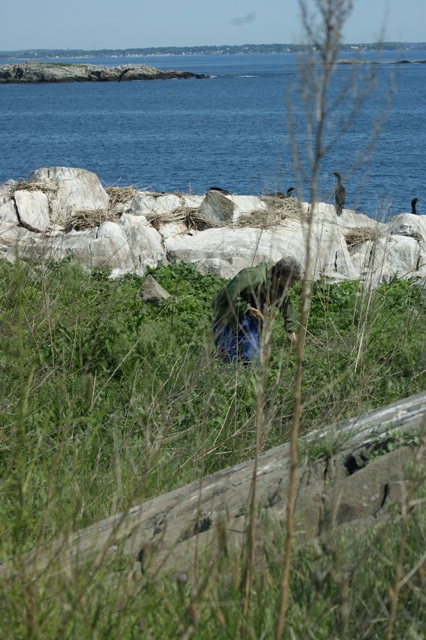
Waterbird Monitoring volunteer Pat Dolan searching for eider nesting on Middle Brewster (CLT, 5.18.2012).
Hoping to avoid the rain and make it too Sarah in the morning!
-Carol
Posted in Birds, Coastal breeding birds, Monitoring | Leave a Comment »
Yesterday (May 14th) was the official launch of the 2012 Boston Harbor Waterbird Monitoring Season!
We had great conditions and started the field season with a ground-based nest count of Common Eider on Calf Island. We were met at the island by a group of federal and state biologists interested in obtaining blood samples from the Boston Harbor nesting colony to further their investigations of ‘Wellfleet Bay Virus’, the newly described virus that is thought to be responsible for recent large scale eider die-offs on Cape Cod. (Check out this recent Cape Cod Times Article on Wellfleet Bay Virus:http://www.capecodonline.com/apps/pbcs.dll/article?AID=/20120310/NEWS/203100335).
- Avian Disease Coordinator, Sam Gibbs, & State Waterfowl Biologist, H. Heusmann band and obtain blood sample from a nesting Common Eider in Boston Harbor. (CLT, 5.14.212)
While the visiting researchers worked on the north end of the island, we counted nests on the southern end of Calf. We found a total of 26 nests, which is a bit higher than the 18 nests found on that portion of the island when last surveyed in 2008. Notably missing were the Black-crowned Night-Herons previously known to be nesting in the lilacs and willows in the center of the island – there were 13 BCNH nests and 30 adults in 2008, and only a few adults and no nests on this visit. We also located two American Oystercatcher nests – one with 2 eggs and one chick!
If you have an interest in eider research, you may enjoy these beautiful photos from a project going on in my neck of the woods…. Common Eider Research in Rhode Island: http://coastalbirds2.blogspot.com/2010/01/wintering-ecology-of-common-eider-in.html
Back out in the island on Thursday…stay tuned.
-Carol
Posted in Uncategorized | Leave a Comment »
Alas, another season is behind us… We finished up our 2011 efforts with two trips on July 19th and 26th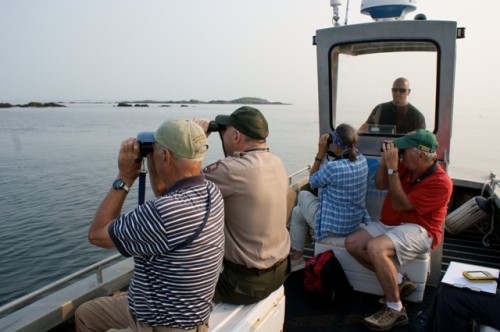
- Boat-based Surveys (CLT, 7/19/2011).
On the 19th, we began our day with a boat-based survey in the Outer Islands. We counted a total of 519 female Common Eider and 97 ‘distinguishable ducklings’. (It was recently pointed out to me that ‘ducklings’, as opposed to ‘chicks’, is the preferred nomenclature for referencing juvenile eider. I have further qualified it with ‘distinguishable’ since, by this point in the season, some ducklings are undoubtedly large enough to escape our notice and get counted as adult females.) Anyway… in addition to 97 distinguishable ducklings, we also detected 2 adult American Oystercatchers with 1 fledged juvenile on Calf Island and another group of 2 adults and 1 fledged juvenile on Outer Brewster. Foraging Spotted Sandpipers were noted on Green, Outer Brewster, Shag Rocks, and Little Brewster and 1 harbor seal was spotted on the Graves. After a season counting eider ducks in Boston Harbor, some of you may be interested to know that this species has a long history of human interaction and sustainable eiderdown harvest still takes place in Canada, Iceland, and other areas of the Artic today. The Norwegian Island of Vega was recognized as a UNESCO World Heritage Site in 2004 and has since been added to my dream travel list (see http://whc.unesco.org/en/list/1143).
The Least Tern colony on Lovells Island has dispersed after what appeared to be a successful season. The Great Black-backed Gull that nested just outside the colony still lingers in the area with one fat and healthy chick. A carcass found nearby may have been the second chick, who was not in evidence during our visit. One Spotted Sandpiper, acting quite territorial, was also noted nearby on Lovells.
In addition on the 19th, we also observed two adult American Oystercatchers with 1 fledged juvenile on Peggy’s Point on Gallops Island, but did not see any on Rainsford during a boat-based survey. Eight Wilson’s Storm-petrels were working the water between Lovells and George’s and Spotted Sandpipers were foraging on both Gallops and Rainsford, presumably having completed their nesting efforts for the season.
On the 26th, we took advantage of the morning high tide and landed on Snake Island where we observed 10 adult American Oystercatchers and 5 fledged juveniles along with 34(!) Willets. There were 7 adult Common Terns in the area. We came upon one abandoned tern nest with 2 eggs and then, quite surprisingly, found 2 very young Common Tern chicks on the beach. Although we saw terns in the area during our initial visit in late May, the end of July is quite late for nesting terns. Black-crowned Night-herons, a Great Blue Heron, a Great Egret, Least Terns, Short-billed Dowichers, Greater Yellowlegs, Lesser Yellowlegs, Semipalmated Plovers, Semipalmated Sandpipers, Song Sparrows, Red-winged Blackbirds, and European Starlings were all foraging on Snake – more evidence that the breeding season is over and fall is shortly upon us.
During a boat-based survey of the Outer Islands on the 26th we counted 426 female Common Eider and just 21 ‘distinguishable ducklings’. Ducklings born in May or early June should be approaching full size and are quite capable of traveling across open water to feeding sites along the mainland. It is not at all surprising that so few young ducklings were present and very much appears to have been a successful season for eider overall. Adult American Oystercatchers were detected on Little Calf, Calf, Green, Outer Brewster, and Shag Rocks (with a fledged juvenile?). One Great Cormorant and 1 gray seal were observed on the Graves and a single Spotted Sandpiper on Middle Brewster.
We ended our day with a landing on Sheep Island where we spotted 9 American Oystercatchers, at least one of which was a fledged juvenile. One adult had a yellow leg band, one letter of which was ‘K”. An adult with code YE(CK) was banded on Sheep in 2009 and re-sighted in 2010, so it may have been the same individual again. Also on Sheep were nesting Herring and Black-baked Gulls, Double-crested Cormorants, Glossy Ibis, Black-crowned Night Herons, Snowy Egrets, and Great Egrets. We noted at least 7 Spotted Sandpipers, along with Least Sandpipers, Ruddy Turnstones, Semipalmated Sandpipers, and Semipalmated Plovers all foraging in the intertidal.
Posted in Boston Harbor Islands, Coastal breeding birds, Monitoring | Leave a Comment »
A perfect summer day in Boston Harbor! Where were days like these back in May when we needed them?
We counted a total of 117 eider chicks during a survey of the Outer Islands (down from 159 last week). Chicks were attended by 110 females, with an additional 326 females in the area. This means a total of 436 females detected, as compared to 443 on our June 28thsurvey. Pretty similar numbers!
There was definitely a sense that summer had arrived. We noted many Wilson’s Storm-petrels in the Outer Harbor, several gray seals were hauled out on the Graves, and Spotted Sandpipers were observed actively feeding in the intertidal zones of Calf, Green, Middle, Outer, and Little Brewster. We had several American Oystercatchers calling in flight near Calf and observed one adult on the landing beach there. We observed 4 adults in flight along the east side of Calf later in the morning, though it was not clear if these were the same individuals or from where they were coming. One AMOY adult was also observed on the landing beach on Middle Brewster where previously detected.
The Least Tern colony on Lovells remains quite active with several chicks close to fledging. There were approximately 35 adults attending the colony. Given the timing and the lower adult numbers (and two very fat gull chicks nearby) it seems likely that some predation has taken place, though in general the colony was still very active. No American Oystercatchers were detected on Lovells.
Back out on a couple weeks!
Posted in Uncategorized | Leave a Comment »
